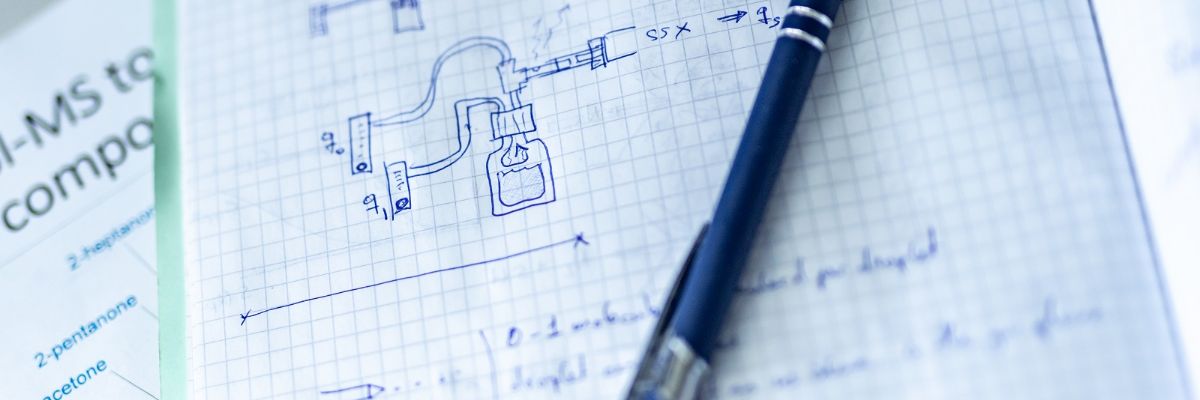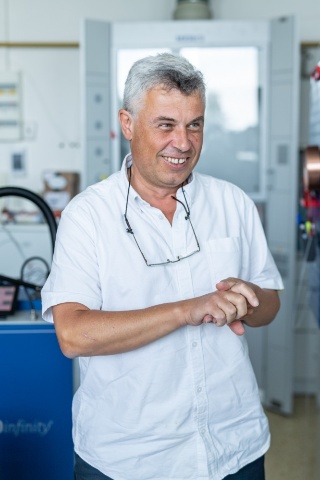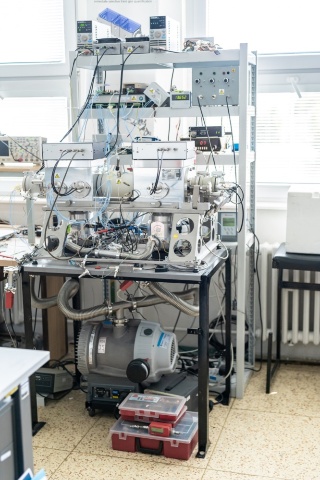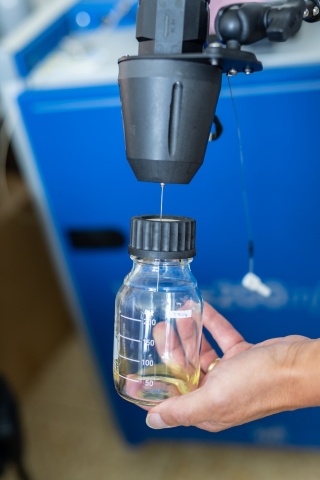
A device which detects substances in human breath with molecular-level precision
03. 10. 2022
At the beginning of his scientific career, Prof. Patrik Španěl searched the depths of interstellar space for organic compounds. Later, he turned to terrestrial life. His method of mass spectrometry, a technique used to measure substances in gases with extreme precision, has been used for many years in various fields of human activity: improvements in the manufacture of chips, safety checks in the production of medication, ensuring the safety of transport, but also in detecting certain diseases from our breath. What principle does it work on? And does it have potential to serve as a diagnostic method in medicine? We visited the labs at the J. Heyrovský Institute of Physical Chemistry of the CAS to get some answers.
Crohn’s disease is a chronic disease of the digestive tract that affects about three people in one thousand. It causes painful inflammation, fevers, prolonged diarrhoea, chronic fatigue, and weight loss. Its exact causes are not known but are believed to be genetic in origin. Statistically, the incidence of Crohn’s disease in the population has been on the rise for several decades. However, there is no cure, and treatment focuses only on suppressing the symptoms. The earlier the disease is diagnosed, the easier it is to efficiently alleviate its symptoms.
Individuals suspected of having Crohn’s disease have to undergo a series of invasive tests: blood tests, a colonoscopy, an endoscopy of the upper digestive tract, and usually a biopsy during which a tissue sample is taken. A quick and non-invasive method that could detect the disease before symptoms erupt would not only provide relief for patients but also help in timely prevention.
In the past, medical research has indicated that inflammatory diseases of the digestive tract, such as Crohn’s disease, go hand in hand with elevated levels of pentane in human breath. Pentane is one of the volatile organic compounds that can be detected with great accuracy by gas chromatography–mass spectrometry, an analytical technique that Prof. Patrik Španěl from the J. Heyrovský Institute of Physical Chemistry of the CAS has been involved in developing for decades now.

Patrik Španěl’s research is fundamentally interdisciplinary, combining findings from physical chemistry, electrical engineering, but also, for instance, biomedicine.
The technique is so sensitive that it can determine concentrations in the order of 10-9. In other words, in air or human breath, it can identify units of molecules among billions of others. To visualise this: it could detect a thimbleful of foreign fluid in a swimming pool. “Personally, though, I prefer the poetic simile that it can precisely define a single second of an entire human lifespan,” Patrik Španěl tells us as he shows us around his laboratory. The mass spectrometry technique can also detect other volatile substances, not just organic ones: ammonia or hydrogen sulfide, for instance.
How does spectrometry detect which substances are present in the human breath? The process is simple: it weighs the individual molecules, using an electrical charge to make the measurement. Specific molecules are charged (i.e., ionised), and then their mass is determined using electric or magnetic fields. The spectrometer then determines which kinds of substances are present and in what quantities. No other comparably sensitive technology exists today.
Standard mass spectrometry is commonly used in non-scientific applications. “Doctors routinely take a drop of blood from the heel of each newborn baby. This blood is then dried, and the samples are analysed spectrometrically in two independent laboratories,” Španěl describes a common practice in maternity hospitals. The aim of this examination is to determine whether the baby could be suffering from a metabolic disorder such as phenylketonuria. This is a disorder of digestion of phenylalanine, an amino acid found in meat, eggs, milk, flour, legumes, and artificial sweeteners. If undetected, there is a risk of severe brain damage if even small amounts of phenylalanine are ingested. In these such cases, mass spectrometry literally saves lives.
From cosmic to human life
More than two hundred researchers in the Czech Republic are involved in the development of mass spectrometry. Patrik Španěl’s research focuses on finding new ways how it could be applied. Some of the paths he is taking are as of yet unexplored and necessarily pioneering. “We study the reactions of gaseous molecules and what they result in. When we find that out, we can then look for them and make precise measurements,” Španěl explains. He conducts his research from scratch, starting with developing the methods themselves. Then comes the designing of new instruments and applications in biomedicine and other research areas.
The beginnings of gas analysis date back to 1990. But back then, the instruments were built for a different purpose: to research organic reactions in interstellar space. In the vacuum of space, molecules also get ionised by radiation and form more complex organic compounds. A specific type of mass spectrometry, called SIFT-MS, was designed to reveal the mechanism of these reactions.
Patrik Španěl recalls why he eventually left the world of interstellar chemistry. “It was an interesting field, but I felt there was a certain degree of navel-gazing,” he explains. Even then, he was already tempted by ideas of how the new instruments could be used in a different way. There were potential uses in food processing and breath analysis. When he returned to the Czech Republic and accepted a position at the J. Heyrovský Institute of Physical Chemistry of the CAS, he was given free rein research-wise, but he had to set up his own laboratory by himself. With his colleague David Smith, who this year received the Jaroslav Heyrovský Honorary Medal for Merit in Chemical Sciences, he brought to the Czech Republic outdated equipment from England and established the laboratory, which he still runs today under the Department of Chemistry of Ions in Gaseous Phase.

The lab is not just about testing substances, but also about designing the next generation of measuring devices.
The equipment that Patrik Španěl is showing us is a far cry from the original lab setup. About 90 centimetres high and 70 centimetres wide, it’s the kind of contraption that would have gone unnoticed by us. When switched on, the device starts to suck in the surrounding air from its nozzle, analysing its contents. The result is a wildly curved graph, from which experts are able to decipher the composition of the gaseous sample.
Researchers are constantly improving the instruments and expanding the catalogue of substances they are able to detect in the gases. It contains hundreds of organic and inorganic compounds. “It is important that the device only measures trace components, not the main components of air, such as oxygen, nitrogen, or water vapour,” Španěl explains. The accuracy of the measurement is not affected by the temperature in the lab.
But there are a number of variables that affect the results. And implementing the instrument in medical diagnostics, for instance, where a high degree of reliability is essential, still remains in the realm of sci-fi – for now. Certain chemical substances found in human breath can be an indication of colon cancer, but they can also be found in the breath of healthy people. Where clinical accuracy is not needed, implementing the method is already being considered. “Our colleagues at Imperial College London have developed a method of screening for oesophageal cancer using breath analysis that singles out patients at increased risk as candidates for gastroscopy,” Španěl adds.
A little helper for every industry
Outside of healthcare, the technique has been utilised for many years. In South Korea, for instance, the device is used to check the perimeter of a chemical factory for harmful substances potentially leaking into the surrounding area. Currently, the most important use of SIFT-MS is in the manufacturing of semiconductors. Transistors, the basic components of processors, are getting smaller. As a result, more of them can fit into the chips and the electronic products thus have a higher capacity. Their size is a few nanometres, and at such a miniscule size, a single speck of dust can destroy an entire batch of chips. However, mass spectrometry can save the day by checking the air quality to ensure impurities located in the environment do not disrupt production.
It also protects workers in the transportation industry: if customs officers suspect that a shipping container contains hazardous substances or explosives, the device is used to analyse the air to determine whether there are any inside. In the pharmaceutical industry, it monitors the purity of products used in the manufacture of medication. In the food industry, it can detect pesticide residue on, for instance, sesame seeds and nuts. It is also used to detect the origin and quality of olive oil.
Did you know that Italy reportedly exports about four times more olive oil annually than the local farmers can produce? Most of it comes from Greek and Spanish olives and is only bottled in Italy and labelled with the ‘Made in Italy’ trademark. However, the fumes released by Italian olive oil have a slightly different composition to those of oil from other countries. Yes, you guessed right: mass spectrometry can detect these differences. Companies that are interested in the origin of the oil can therefore make certain that they are truly getting what they paid for.

Analysing the composition of the olive oil fumes, the instrument can determine where the olives from which the oil is made come from.
On receiving the Academic Award in autumn 2021, Patrik Španěl revealed where his research efforts would take him next. With a team that is tirelessly expanding the catalogue of substances that his instrument is able to detect, and with a robust analytical technique used by companies around the world, Španěl intends to do what he does best: to push the envelope and to exceed the limitations of current mass spectrometry of gasses. The limiting factor now is primarily the design and structure of the device, which makes it difficult to use in the field. So Španěl is working on a concept for lighter and more portable instruments. “We are currently designing equipment for testing and then, within the next two to three years, we would like to design a prototype of a smaller device,” the researcher concludes as he shows us the work in progress on the new device in the lab. It is therefore quite possible that in time, Španěl’s spectrometers will become more and more part of non-scientific fields and everyday life.
________________________________________
Prof. RNDr. Patrik Španěl, Dr. rer. nat.
He graduated in physical electronics and vacuum physics at the Faculty of Mathematics and Physics, Charles University in Prague, then studied ionised gas physics at the Leopold-Franzens Universität in Innsbruck. He has been working at the J. Heyrovský Institute of Physical Chemistry of the CAS since 1997, where he serves as Head of the Department of Chemistry of Ions in Gaseous Phase, Vice Director for Science, and Chairman of the Board. Since 2002, he has also been a Professor of Chemical Physics at Keele University, England, and is currently a Visiting Professor at Imperial College London. He has authored and co-authored over three hundred studies in scientific journals, which have been cited more than 12,000 times. Last year, he was awarded the prestigious Academic Award of the CAS.
________________________________________
This article is taken from the Czech-language A / Věda a výzkum magazine, published by the Czech Academy of Sciences:
Prepared by: Jan Hanáček, Division of External Relations, CAO of the CAS
Translated by: Tereza Novická, Division of External Relations, CAO of the CAS
Photo: Jana Plavec, Division of External Relations, CAO of the CAS
 The text and photos are released for use under the Creative Commons license.
The text and photos are released for use under the Creative Commons license.
Read also
- The undeniable benefits of breastfeeding for the health of babies
- Straws as a symbol of pollution: single-use plastic products are on their way out
- Eleven researchers received honorary medals from the CAS for their service to science
- Aqueous batteries: a promise of cheap and safe energy for the future?
- Czechoslovakia in the Orient: The Orient in Czechoslovakia exhibition opens
- The little owl on the brink of extinction with a weak 2022 nesting season
- Maths today: from gas pipeline operation and noise to artificial hearts
- Two years of COVID-19: economists describe how the pandemic affected our lives
- Energy of the future: researchers boost solar cell efficiency with perovskites
- GMOs, energy, resilient society: the focus of the Czech EU Presidency
The Czech Academy of Sciences (the CAS)
The mission of the CAS
The primary mission of the CAS is to conduct research in a broad spectrum of natural, technical and social sciences as well as humanities. This research aims to advance progress of scientific knowledge at the international level, considering, however, the specific needs of the Czech society and the national culture.
President of the CAS
Prof. Eva Zažímalová has started her second term of office in May 2021. She is a respected scientist, and a Professor of Plant Anatomy and Physiology.
She is also a part of GCSA of the EU.
